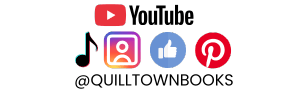Why You Shouldn't Claim Your Instagram on Pinterest If You Want to Grow
My Pinterest Experience as a New Author
A year ago, I started my author journey on Instagram. Like many new authors, I was juggling a lot—launching my first book, promoting it on social media, and trying to show up everywhere at once. When I saw Instagram had a feature that automatically shared posts to Pinterest, I thought, Perfect! I don’t have to do double the work.
So I set it up, left it alone, and got back to writing. I published a second book and posted to Instagram regularly, assuming my content was also doing its job on Pinterest.
But then one day, I decided actually to check my Pinterest analytics.
And what I saw surprised me: almost no clicks, barely any impressions, and definitely no engagement. I knew little about Pinterest then, but I could tell something wasn't working.
So I started digging.

Realizing the Problem
At first, I thought maybe I just needed a little boost. So I tried running Pinterest ads—$3 a day, just to see what would happen. Still nothing. Then I watched a YouTube video that explained how Pinterest relies heavily on titles, descriptions, and keywords to categorize and push your content.
When I went back to look at my pins more closely, I saw it: they were a mess.
Many of them said things like "Profile" or had no titles or descriptions at all. Some weren’t even on boards! I had pins with no strategy—just random giveaways with expiration dates, book launch graphics that were no longer relevant, and zero evergreen content.
I got to work cleaning it up. I deleted outdated pins, added keyword-rich titles and descriptions, and made sure every pin had a proper home on an SEO-optimized board.
Still, not much changed.

The Breakthrough: Stop Auto-Pinning
from Instagram
The turning point came when I did one more thing:
👉 I stopped letting Instagram post directly to Pinterest.
Instead, I began uploading pins manually, with intentional graphics, keyword-focused descriptions, proper titles, and branded visuals that reflected Quill Town Books.
And let me tell you—what a difference that made.
Almost immediately, I started to see organic traffic pick up. People found my pins, saved them, and even clicked through to my website. For the first time, Pinterest became a tool that was working for me, not just a digital dumping ground for repurposed content.
The Pinterest Ads Wake-Up Call
I spent $495 on Pinterest ads from January 1 to April 28, 2025. That investment brought in about 456,000 impressions, which sounds amazing—until you dig deeper.
Out of all those impressions, I only received:
1,060 pin clicks
Just six saves
That’s it. Six saves.
Those results were all tied to the pins that were automatically coming over from my Instagram account—unbranded, untitled, and unsearchable.
I knew something had to change once I saw that data before me.
I officially paused all my Pinterest ads on April 28th, 2025.
That moment became a turning point for my strategy.

The Power of Manual Uploads and Branding
After pausing my ads, I stopped linking my Instagram to Pinterest altogether. Instead, I began uploading pins manually—each one designed with a clear purpose. I made sure they had:
Branded visuals with my signature colors
Keyword-rich titles and descriptions
Strategic placement on keyword-titled boards
And the results speak for themselves.
Let’s compare my organic stats:
February 1–March 1 (Before Manual Uploading & Rebranding):
1,079 impressions
15 engagements
0 saves
14-pin clicks
1 outbound click
May 4–June 3 (After Strategy Shift):
7,147 impressions
108 engagements
7 saves
92-pin clicks
11 outbound clicks
This is all organic growth—no paid ads.
That kind of jump didn’t come from doing more. It came from doing it smarter.
Pinterest Is a Search Engine, Not Social Media
The biggest shift in mindset was realizing Pinterest isn’t just another social platform—it’s a search engine. It’s not about being trendy or getting instant likes. It’s about creating evergreen content that works for you long after you post it.
Pinterest is the long game. Now, it’s one of my favorite tools for growing my brand, reaching more readers, and connecting with families and educators who are looking for exactly what I offer at Quill Town Books.
Come Take a Peek at My Pinterest!
If you're curious about the difference, I’d invite you to visit my Pinterest profile. Look around, explore my keyword-rich boards, and check out how I organize pins for authors, teachers, and book-loving families. You’ll find tips, free printables, merch, and inspiration for children’s book creators like you.
I hope my journey helps you make the most of Pinterest, too!
Like what you read?
Get more inspiring tips, creative ideas, and helpful resources, delivered straight to your inbox 1–2 times a month.
Subscribe to the Quill Town Books Blog now and never miss a post!




